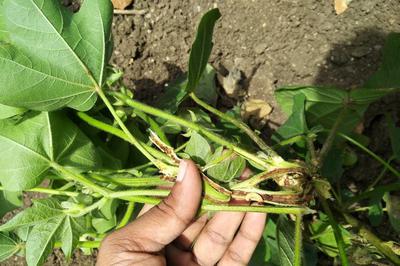Cotton Stem Weevil
Pempherulus affinis
Insect
5 mins to read
In a Nutshell
- Knot-like swelling of the stem, just above the ground.
- Wilting and drying of plant.
- Stunted growth.
- Stems can easily lodge.
- Young plants are killed.
- Small, dark with white tones on their wings covers and head.
Can also be found in
Symptoms
The most distinctive symptom of an infestation by the cotton stem weevil is the knot-like swelling of the stem just above the ground. This is due to damage to the vascular tissue caused by larvae feeding inside the stem. Young plants are invariably killed as a consequence of the damage. Older plants show symptoms of wilt first and gradually dry up. They are more likely to survive but will have poor vigor and stunted growth. The affected stems can easily lodge when strong winds blow or due to a heavy boll load. Further symptoms are reduced number of bolls and poor quality of the fibers.
Recommendations

Organic Control
Application of Neem cake to the soil mixed with farmyard manure (FYM) during the basal fertilization can reduce the chance of stem and shoot weevil infestations (10 tons FYM + 250 kg of Neem cake/ha). Furthermore, young plants can be drenched with a Neem oil solution to prevent adult weevils from laying eggs onto leaves. Pheromone traps can be used for weevil monitoring and control (combined with an bio-insecticide)

Chemical Control
Always consider an integrated approach with preventive measures together with biological treatments if available. A preventive treatment of seeds (10 ml of chlorpyrifos 20 EC/kg of seeds) can be used to limit the spread of the insect. Spray treatment of the stem collar with chlorpyrifos 20 EC is also effective against stem and shoot weevils (dilution of 2.5 ml/L). Drench the plants at 15 day intervals, starting 15-20 days after germination. Pheromone traps can be used for weevil monitoring and control (combined with an insecticide)
What caused it?
Damage is caused by the cotton stem weevil, Pempherulus affinis. Adult weevils are small, dark brown in color, with white tones on their wing covers and head. Females lay their eggs in the growing shoots of young plants. After hatching, the white grubs burrow into the stem between the bark and stem, and start feeding on the vascular tissues. This causes the typical swellings on the stem just above the ground level. The cotton shoot weevil (Alcidodes affaber) behaves in a very similar way. Therefore, the same treatment and prevention measures can be applied. However, cotton shoot weevils are dark grayish brown with pale bands on their forewings. Cotton stem weevil can occasionally be a serious pest in some parts of South India, particularly Tamil Nadu.
Preventive Measures
- Use dense spacing between plants to hinder the insect.
- Earth up along the rows of seedlings to hinder the weevil.
- Reduce cropping intensity, e.g.
- by planning a fallow or a crop rotation.
- Remove alternate hosts in and around the field (hibiscus, Indian mallow).
- Monitor fields and remove affected plants.
- Remove and burn plant residues after the harvest.
- Use pheromone traps to monitor the presence of the weevil.



